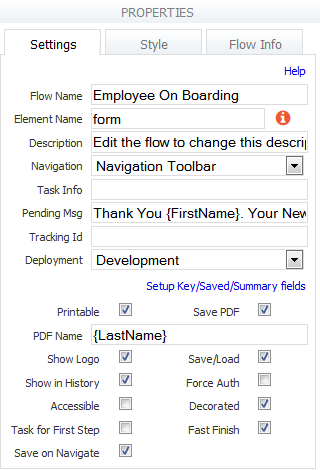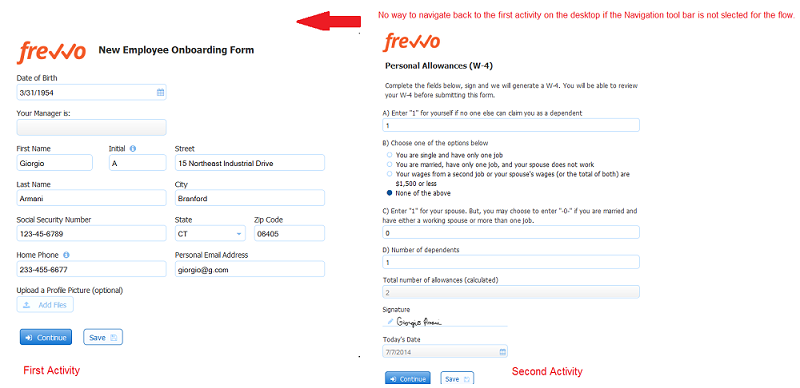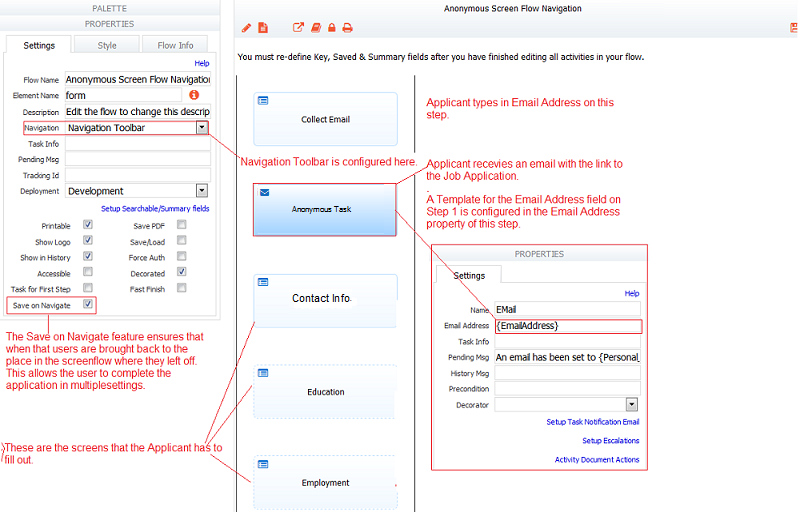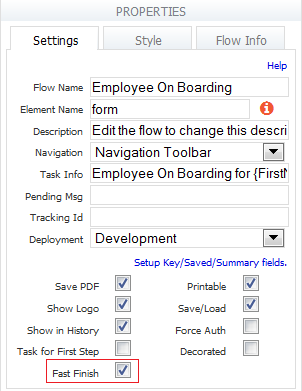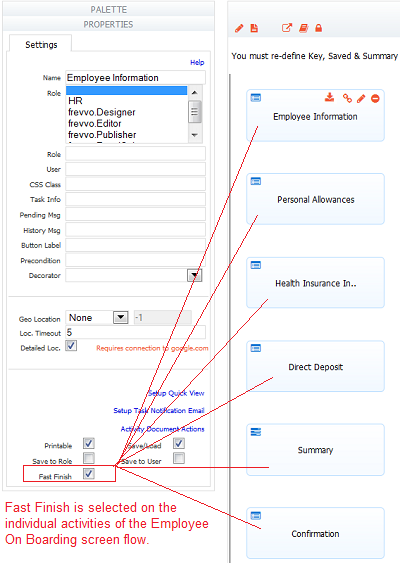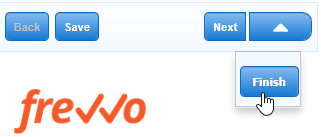Live Forms v7.4 is no longer supported. Please visit Live Forms Latest for our current Cloud Release. Earlier documentation is available too.
Flow Setting Properties
Each flow property setting is described below.
On This Page:
Flow Name
This is the name you see on the Flows home page where your flows are listed. We recommend changing the name to make it more meaningful than the arbitrary name assigned when you create it, but keep in mind it is a working name only, so users will not see it. It is recommended that you name your form/flows using characters that are suitable for filenames. Following the POSIX filename standard (A–Z a–z 0–9 . _ - ) will ensure it works.
Element Name
There is a now a flow property called Element Name. By default, this is set to form for newly created forms as well as flows. The root element name of the from-scratch document is determined by what you put in here. It needs to be a valid XML element name. The designer can now change the name of the flow without impacting the element name.
Flow schema and the Submission xml document show the element name. When the flow name is updated, and 'Element Name' is kept the same, the previous submissions can be initialized successfully. When 'Element Name' is updated, previous submissions cannot be initialized.
If you change the element name, all existing submissions will become invalid and you will get the error message: " Error. Submission is not valid. An incompatible change was made to the form/flow."
Description
By default all flow descriptions say, “Edit the flow to change this description,” but you can change this if you wish. The description appears as a tool tip when you mouse over the area just to the right of the flow's share icon on the Flows home page. You also see this description when you view individual submission documents.
Navigation
can automatically generate and display a navigation toolbar for your flow which users can use to navigate back and forth between workflow steps. There are four available options:
- None: This option displays no navigation toolbar. This is useful for situations where the same form is being passed between users for signatures e.g. Vacation Request workflow filled in by an Employee and signed by a Manager.
- Navigation Toolbar: this displays a standard navigation toolbar with links for each step.
- Percent: This displays progress through the flow as a percentage.
- Step 1 of 4: This option displays progress through the flow as a counter.
The default value for Navigation is Navigation toolbar. When you configure the Navigation toolbar for your workflow, users will see the following:
- The name of the current step displays with a bright blue color. Note that the active step number is also circled in bright blue. Steps that have yet to be performed display with a light blue color.
- HTTP Wait-Notify and Anonymous Task steps, once performed, display with a faded blue color indicating that the flow cannot be reset to this step.
- Skipped steps display with a light blue color and steps that have already been performed display with a black color. For example the Expense Report workflow shown in the image, has four steps: Expenses, Reviewer, Supervisor and Accounting. The employee fills out the Expense report for an amount less than $5000.00. The flow is routed to a company reviewer and if approved, to Accounting for final processing. If the amount of the expense had been greater than $5000.00 then the flow is routed to a Supervisor for an additional review before navigating to the Accounting department. The Supervisor step is skipped for Expense reports less than $5000.00. When the Accounting employee performs the task, here is what they will see:
- The Expenses and Reviewer steps display in black since they have already been performed.
- The Supervisor step is displayed in faded blue because it was skipped as the total amount of the expenses was less than $5000.00.
- The name and number of the Accounting step, which is the step that is currently being performed by the Accounting employee, display in a bright blue color.
Refer to the precondition topic to see how to use them to skip a step in a workflow.
Mobile vs Desktop Behavior
You may notice a difference in behavior when using a flow on the desktop vs on a phone/tablet. For Example: Imagine a two step flow where 1st step has 2 pagebreak controls and neither step has an assigned role/user. On the phone/tablet this translates into a screen flow with 3 steps for 1st step and 1 step for 2nd step. You can use the Previous button to get back to the 1st step from the 2nd step.
However, on the desktop there is no "Previous" button so once the flow gets to 2nd step there is no way to get back to 1st step. If the designer does not configure the Navigation Tool Bar in this situation once the user gets to the second step in the flow, there is no way to return to the first step.
Anonymous Screenflow Navigation
Important Design Fact
Use of the Anonymous Task step requires that the ACL for "who can use the flow" is set to Pubic.This is because your flow now contains a step that is performed by a person who is not an authenticated user - someone who is not logged into
Note: If you want to control who can use the flow, then set a role(s) on the first step of your workflow.
A screenflow is a type of workflow consisting of a collection of sequential steps performed by the same user. What if you wanted that user to be anonymous? Configuring the Navigation Toolbar in an anonymous screenflow allows anonymous users to navigate back to a previous step in a screenflow. The set of available links is restricted to the steps that are executed in sequence by the anonymous user. Links to steps outside of the screenflow are not visible. The steps in the screenflow cannot have a role, dynamic role or user property assigned to them.
Configuring the Save on Navigate feature enables the screenflow to be completed in multiple sessions.Let's consider a Job Application workflow with the following requirements:
- The workflow is going to be performed by anonymous users. Anonymous users do not sign in to
.
- The anonymous user receives an email that includes a link to the workflow.
- The workflow must collect a lot of information from the applicant: Contact Information, Education and Employment history, References and more. You can create one long form or design a screenflow with an Anonymous Task step and subsequent steps as separate screens to collect the information.
- The user must have the option to compete the screenflow in multiple sessions. Clicking on the email link takes the user back to the last step in the screenflow where the Continue button was clicked.
- The user must be able to navigate back to previous steps to review or update information that was previously entered.
Flow Designer
- The Save on Navigate checkbox is checked and the Navigation Toolbar is configured on the Flow Property Panel
- Step 1 of the screenflow has a field named EmailAddress that collects the applicant's email address.
- Step 2 is an Anonymous Task step.
- All remaining steps in the screenflow are designed to collect the applicant's information: Contact Info, Education and Employment history, references etc. Remember, these steps cannot have a role, dynamic role or user property assigned to them.
The image shows an example of a possible screenflow design:
Use Mode
Anonymous Users can return to a previous step by clicking on the Navigation Toolbar.
Visibility
The visibility field has been removed from the flow property pane in the Live Forms Flow designer. Flow Visibility is selected via the Access Control List wizard. You can access the wizard by clicking on the icon for your flow on the Flows Home Page . If you are in the flow designers, click the icon in the toolbar to display the wizard. Flow Visibility has the same meaning as Visibility for forms. The one exception is the custom option which is not provided for flows. The default value for flows is Public in Tenant.
Task Info
When you save a partially filled flow to continue it later or when puts a task on your task list as part of a workflow, the task is accessed via your task list. This field controls the name that gets displayed in the user's task list. For more details, see the Tasks documentation. This field can use templatized strings for dynamic content, e.g. the Task Info can contain "Vacation Request for {FirstName} {LastName}" where FirstName and LastName are the names of fields in a form from a prior step in the flow. Before putting the task on a user's task list,
will resolve the Task Info string using the actual values of the FirstName and LastName fields e.g. "Vacation Request for Tom Smith".
will truncate the Task Info data to 250 characters.
You access your Task List from your applications home page. You use the Task list to to perform tasks assigned to you, to view a task's history, or search for tasks you've participated in — a tenant admin can also search for other users' tasks.
Pending Msg
This is the message that is displayed on the screen during a workflow when the next step must be performed by a different user/role and puts it on that user's task list. For example, in an Vacation Request workflow, the first step may be filled in by an Employee but the second step (approval) must be signed by a Manager. When the Employee clicks Continue,
will put the task on the Manager's task list and display this message on the Employee's screen. This message can use templatized strings for dynamic content, e.g. the message can be set to "Thank You {FirstName} {LastName}. Your request has been submitted to your manager for approval." where FirstName and LastName are the names of fields in a form from a prior step in the flow. Before putting the task on a user's task list,
will resolve the pending message using the actual values of the FirstName and LastName fields e.g. "Thank You Tom Smith. Your request has been submitted to your manager for approval.".
This property can be set at the flow or flow step level. If you set up a message at the flow level, it will display after the Continue button is clicked on each step of the flow except for the last one. On the last step, you will see the default message, "Thank You!. Your submission has been received" unless you customized the message using the Form Action wizard.
To set up a message at the flow level, follow these steps:
- Click the icon for your flow on the Flow Home page.
- Click the Toolbar to display the flow properties pane.
- Type your message in the Pending Msg box.
This will work if you want the same message to display for all of the steps of your flow. Typically, designers want to display different customized messages after each step. If this is the case, you must set the Pending Message at the flow step level.
Tracking Id
See Tracking Id described in designing forms.
Deployment
This field is a toggle that sets the state of your flow to production or development. Functionality is the same as Deployment for forms.
Printable
If you check a flow's printable checkbox a Print button will be displayed in Summary steps of the flow. If you don’t want users to print your flow, uncheck the checkbox so users will not see the Print button. You can control which fields are printed by setting up which fields are displayed in the Summary View as described below.
Flows do not currently support a print icon as is available on forms. This will be added in an up coming release. One solution is to add your own print link as discussed in the chapter Printing Forms.
Each step also has a printable property which controls whether or not that step appears in the PDF document view . See the printable property for workflow steps for full details.
Setup Searchable/Summary Fields
Searchable fields configured for a form or flow are the fields that may be used to filter submissions in the submissions view. By default, all your data is saved as an XML document. This is the most efficient way to store/access your data both in terms of speed as well as storage. However, if you prefer to view your data via the submissions user interface, you can choose which fields are available to the user as search criteria in addition to the XML data.
Considerations when deciding which types of fields to configure are listed below.
Searchable fields are indexed for easy search of form/flow Submissions. They can also be used when searching Tasks on a user's Task List. You will see the controls designated as Searchable fields in the Submissions table. This is helpful when trying to locate a particular submission from a long list. They are downloaded into the Export Submissions to a CSV file along with the submission default columns. The default for the maximum number of Searchable fields is 10. In-house customers can change change the default value by adidng the frevvo.max.searchable.fields configuration parameter to the <frevvo-home>\tomcat\conf\Catalina\localhost\frevvo.xml file.
Saved fields do affect performance as they are independently stored in addition to XML data. This can significantly reduce performance, especially for large forms and require additional storage in the repository. Saved fields are not rendered in the submission table and cannot be used as search criteria for submissions. The only reason to configure Saved fields is if you want to use the Export to Excel feature which is available on the Legacy Submissions view
The Submissions Legacy view and the Export to Excel feature will be removed in the next major release. Please use the redesigned Submissions view as soon as possible so you can become familiar with the added functionality and the submission export to a csv file.
Designers should carefully consider which fields to designate as Searchable fields. The selection of the correct fields as search criteria can be very helpful with submission and Task List searches.
Clicking on the Setup Searchable/Summary fields link displays a wizard. The wizard displays the fields from your flow on the Available Fields tab . Drag and drop or use the arrow keys to move the available fields to the Searchable Fields list. If the Legacy Submissions view is configured, designers will see a Saved fields tab listing the fields used for the Export to Excel feature. The Saved Fields tab will not display when the Legacy Submissions view and the Export to Excel feature are removed in the next major release.
Please refer to the Setup Searchable Fields documentation for forms for information about how the wizard works.
In a flow, controls are listed in the Available and Saved Lists using the control name. If you change the name of a control in a flow step, it will unset the saved field. The newly renamed control will now show on the Available list and the designer must move it to the Saved List again by clicking on the Setup/Key/Saved/Summary Fields wizard.
Summary Fields
Check the individual fields to select the fields you want to appear in the Summary view if you have a Summary step in your flow.Only checked fields will appear in the Summary. There are also two checkboxes labeled "All" and "None" which will show all the fields or none of the fields, respectively.
These controls are excluded from the Summary Fields list:
- Signature
- Formviewer
- PageBreak
- Message
- Link
- Trigger
- Image
- Video
Save PDF
When checked a PDF image of the flow is saved in ' submission repository. See the documentation for the submissions repository for details on viewing the PDFs saved there.
Since flows are a combination of multiple forms or a single form visible in multiple steps or a combination of the two, it is important to understand what controls will be printed when the PDF is generated. See the topic discussing the step printable property. Notice all controls, including those disabled or in a signed section, are no longer grayed out in the pdf.
PDF Name
When you check Save PDF on the flow Property panel, an optional PDF name field displays. It is only visible when the "Save PDF" property is checked and is disabled when the "Save" property is unchecked. If this new property is set, then it is used to name the generated PDF. You can use templates to name the pdfs.For example, let's say you have an Employee Onboarding flow for new employees and you wanted the pdf in the submissions to be named using their last name. Simply add the name of the control in your flow that collects the last name as a template ex:{LastName} in the PDF Name property. The pdf for each Employee Onboarding submission will then be named {LastName}.pdf.
If the PDF Name property is empty, then the form name is used as the pdf name. It is recommended that PDF Names use characters that are suitable for filenames. Following the POSIX filename standard (A–Z a–z 0–9 . _ - ) will ensure it works.
PDF names can contain special characters with the exception of curly braces {}.
In the submission, the pdf for the Onboarding for new hire Eric Armani is named as shown as shown:
Show Logo
This property is checked by default and causes the “powered by frevvo” logo to appear on your flow. Uncheck the checkbox to remove the logo from your flow.
Save/Load
If you check this checkbox on the flow level and on the step level, a Save button will be displayed for each step in your flow. If you don’t want users to be able to save partially completed flows and continue them later, uncheck the checkbox so users will not see this button.
This feature is useful for flows containing lengthy forms where your users may not have all the information required to complete the form in a single session. By clicking on the Save button, a copy of the flow with all the current values is saved by .
will also generate an entry in the user's task list from where the user can continue working on the flow at a later time.
If you are not authenticated, clicking the Save button will display an authentication dialog that requires you to login. See documentation on using forms for more details.
Users can repeat the save/load steps as many times as they wish.
Saved flows can be monitored in the Submissions Repository. Saved flows can contain invalid data and can also contain required fields with no values yet entered. When such a flow is re-loaded the missing and invalid values are again flagged as such by . And the flow cannot be continued/finished until corrections are made to those fields.
Customizing the Save Button Label for Workflows
The Save button label can be customized for each step in your workflow. For example, you can change the button text to Save for Later. This will help clarify the function of the Save/Load feature to your users.
Designers should refer to the Save and Load topic for the details.
Save on Navigate
Imagine you are entering data into a large screenflow and something happens that causes you to navigate away from the flow.. you just lost all your work!. Checking the Save on Navigate property, saves the task to your Task List. Users can go to their Task List to retrieve the task and they will be returned to the screen where they were when the browser was closed. For example, let's say you have a screenflow with steps A > B> C and the user closes the browser at screen B. When the user performs the task from the Task List, the flow will open up at step B.
Here is a short synopsis of when the current location is saved. Consider a flow with the following steps/roles: Role1(A → B → C) → Role2(D) → Role3(E):
- The flow is instantiated and step A is rendered:
does not save because it is the FIRST step (if the user abandons the flow in the browser it is as if it never existed).
- The user clicks next:
saves BEFORE step B renders.
- The user clicks next:
does not save because the role change will do a save to the db in the PENDING state.
- Role2 performs the task: no need to save here since the flow is already saved in the db in the PENDING state.
- Role2 clicks continue:
saves before the step is rendered.
will not save if the step is READONLY - this might be the case if the user navigates back to a previous step that was performed by a different user.
will not save when the flow navigates from an HTTP/Anonymous Task step to the next one.
will not save when the flow is completed.
Screenflows consisting of an Anonymous Task step followed by multiple sequential steps that are performed by an anonymous user bring the user back to the flow at the current/latest anonymous step if the Save on Navigate feature is selected.
Configuring Save on Navigation
This feature can also be turned on globally, If configured on a server level, it will apply to all workflows. You must modify configuration parameters to turn on this feature. If you want to save workflow steps that are partially filled in to the Task List, enable the Save/Load feature in your workflow.
Show in History
If this checkbox is unchecked, tasks for the form or flow will not appear in Task History searches. If you want them to appear, make sure this box is checked. Checking or Un-checking it affects all tasks including ones that were created prior to the action.
Task for First Step
This feature is useful for auto-starting flows programmatically. For example if you need to process a batch of invoices whose metadata is a row in a .csv file:
- you can programmatically process the csv file and auto-start a new flow for each row in the .csv.
- Initialize the form fields with data from the csv.
Another use case may be for a person in the HR department to auto-start a employee performance review by placing new review forms on each manager's task list for each of their reporting employees.
If this checkbox is unchecked and the flow requires a specific role or user to execute the 1st step then a person who tries to use the flow and does not have the required role or is not the specific user will get an error message:
Error Access Denied. Either you are not authenticated or you do not have the proper permissions/role.
If this checkbox is checked, and a person without the correct user or role tries to use the flow, the flow will be auto-started and sent to the task list of the person(s) specified in the user property or the roles list. The user who tried to access the flow will see the Pending Message setup for the first step or the default pending message "Your Request is being processed".
Kick Off Workflow Tasks
It is possible to "kick off" a workflow from a form by using a business rule that performs an http get with the URL to the workflow. The Task for First Step property must be checked in the workflow for this to work. If you are using v7.2+, the raw link to the workflow that you are calling must be in the format discussed below:
- Cloud customers must change http://app.frevvo.com to frevvo:// in the rule that kicks off the flow.
- In-house customers must change the http:<domain>:<port> to frevvo:// in the rule that kicks off the flow.
Refer to Flow Design Patterns for more information.
Fast Finish
The Fast Finish feature is very useful when you're filling a lengthy screen flow. workflows consist of steps (steps) performed by the same person or more than one person. Steps in a workflow performed by the same person are called multipage forms or screen flows. The designer can select the Navigation Toolbar or add a Summary step as one of the steps to provide an easy way to move forward and backwards through the steps of a
workflow.
Let's say a user needed to return to a previous workflow step to change entered data. The user clicks the step on the Navigation toolbar or the edit link in a Summary step and the flow returns to the previous step so the user can make the change. In previous versions, once the change is made, the user would have to click through all of the remaining screen flow steps in order to resubmit the flow with the updated data.
The Fast Finish feature provides a finish button, visible in use mode, in addition to the Submit and Save button (if Save/Load is selected) for the forms in your flow. The Finish button works the same way as the Continue button. The flow will not advance to the next step or be submitted If any of the fields are invalid.
Selecting Finish automatically advances through the flow steps until one of the terminating conditions listed below is true:
- An step is encountered that is not valid - this could be as simple as a required field that was not filled in.
- The next task is assigned to any user/role that is different or the same from the user that selected finish - an example would be the step in the workflow that gets routed to a manager for approval.
- The next task is an Anonymous Task or HTTP step type.
- The last step is valid and submitted.
You can select the Fast Finish property at the flow level or for the individual steps in the flow. Selecting Fast Finish at the flow level enables it for all steps.
To select Fast Finish for all the steps in your flow:
- Edit the flow in the flow designer.
- Click the toolbar to display the Flow Properties panel.
- Check Fast Finish.
Selecting it on the individual steps makes the Finish button available on the designated steps only.
- Edit the flow in the flow designer.
- Click each step in the flow to highlight the properties panel for that step.
- Check Fast Finish.
- Repeat for all the steps in the flow where you want the Finish button to display.
If the steps in your flow consist of forms and/or a summary step, Fast Finish forwards through the steps of your flow until it hits one of the terminating conditions listed above.
Let's consider the Employee On Boarding workflow as an example. This workflow consists of a screenflow that is filled in by the new employee:
- Step 1 is the Employee Information form
- Step 2 is the Personal Allowances form
- Step 3 is the Health Insurance Information form
- Step 4 is the Direct Deposit form
- Step 5 is a Summary step where the employee can review the data. Clicking on the automatically generated Edit links in the Summary View takes the flow back to that step so the data can be edited.
- Step 6 is a Confirmation form for the employee to review the W - 4 pdf information,
- Step 7 is not part of the screen flow - the workflow is routed to the HR department for final processing.
The new employee has filled in steps 1 - 6 but upon viewing the W - 4 pdf realizes that the Additional amount withheld is incorrect. The user clicks on the Personal Allowances step in the Navigation bar to make the correction. If Fast Finish is not selected for the flow, the user must click the Continue button on each remaining step of the flow to submit it with the corrected information.
If Fast Finish, is selected on the flow or step level, the user can click the Finish button after making the correction and the flow will fast forward through Step 6. Fast Finish will stop here since step 7 is assigned to the user Sue who is a member of the Human Resources department. The user will see the pending message after Step 6 and the workflow will be routed to Sue for final processing.
If the Fast Finish and Save/Load features are enabled for a workflow, the user can save a partially completed form to their task list. If the saved form still has required fields that have to be filled in, when the user retrieves the saved task from their task list to complete and submit it, clicking the Fast Finish button takes the user to the point in the screen flow where they left off.
Fast Finish on Mobile Devices
The Fast Finish button on an iPhone or iPad is accessed via a dynamic action menu that is activated by the right-most button in the top button bar. The action menu drops down below the button and floats above the form. If Fast Finish is not selected for the workflow or on the current step, then the action button and menu are not present at all.
Refer to this feature announcement for more information.
Force Auth
See Force Auth described in designing forms.
Accessible
Live Forms can be used to build accessible forms/flows that meet Section 508 and WCAG 2.0 accessibility standards. Check the Accessible property to turn on this feature. Refer to the Accessibility documentation for the details.
Decorated
Decorated is checked by default when you create a new flow. If you uncheck Decorated at the flow level, newly added controls in the forms of your flow will not have a decorator. Controls in the forms that already have decorators will retain them. The designer can select a decorator for each of the steps in a flow that will display on the navigation bar.
